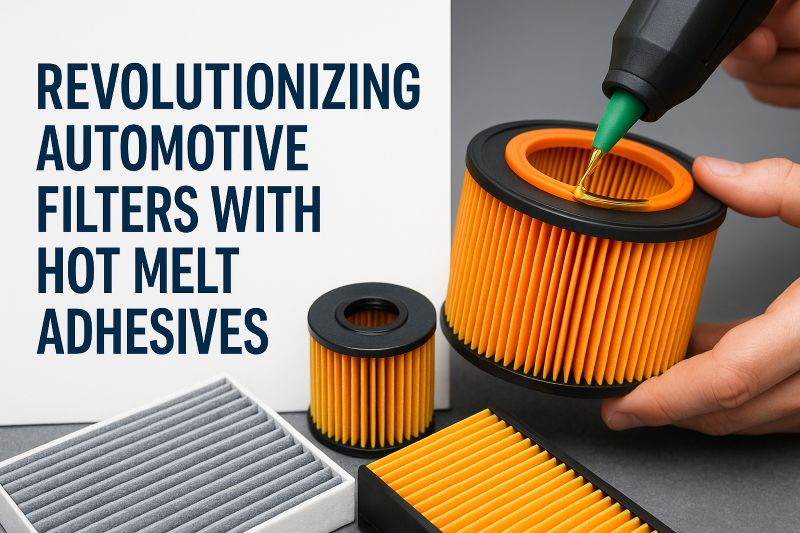
Revolution in Automotive Filters
Defining Hot Melt Adhesives
Types of Automotive Filters
Importance of Adhesives in Filters
Methods of Adhesive Application
Latest Trends in Filter Adhesives
Strategies for Effective Use
Frequently Asked Questions (FAQ)
The automotive industry is witnessing a remarkable transformation, particularly in the realm of automotive filters, thanks to the integration of advanced hot melt adhesives. These materials enhance durability and efficiency, ensuring cleaner engines and longer vehicle lifespans. By offering superior bonding and resistance to environmental stresses, hot melt adhesives contribute to better filter performance and support sustainable manufacturing practices through reduced waste and energy consumption.
Hot melt adhesives are thermoplastic bonding agents applied in molten form and solidified upon cooling, forming strong and lasting bonds. Their rapid setting time and resistance to heat, moisture, and chemicals make them ideal for automotive filters. These adhesives help improve filter efficiency and lifespan, supporting cleaner engine operations and sustainable production.
Automotive filters play a critical role in vehicle maintenance and performance. Common types include:
Air filters: Capture dust and debris to protect engine intake.
Oil filters: Remove impurities from engine oil to support smooth engine operation.
Fuel filters: Block contaminants from reaching the fuel injection system.
Cabin filters: Improve air quality inside the vehicle cabin.
Hot melt adhesives support the structural integrity of these filters, ensuring durability under harsh conditions and enabling lightweight, eco-friendly designs.
Adhesives are essential to maintaining the structure and functionality of automotive filters. High-performance hot melt adhesives provide reliable bonds that hold filter materials together under pressure, temperature fluctuations, and vibrations. Their fast-curing nature reduces manufacturing cycle times, and their clean application minimizes production waste—leading to enhanced operational efficiency and long-term durability of the filters.
Various application methods are used depending on the filter type and manufacturing setup:
Roller coating: Ensures uniform adhesive application over flat surfaces.
Spray application: Ideal for uneven or complex surfaces.
Slot die coating: Offers precise control for intricate geometries and layered materials.
These methods, when paired with the correct adhesive type, optimize bond quality and manufacturing efficiency.
The filter adhesive market is shifting toward higher performance and sustainability. Key trends include:
Development of adhesives that withstand extreme temperatures and chemical exposure
Adoption of eco-friendly, low-VOC adhesive formulations
Integration with automation and precision dosing systems for cleaner, faster application
Hot melt adhesives are central to these advancements, supporting both product reliability and green manufacturing initiatives.
To fully leverage hot melt adhesives in automotive filters:
Adhesive selection must match the material type, operating temperature, and stress conditions of the filter.
Precision application via controlled systems ensures consistent bonding and minimal waste.
Operator training is essential to maximize process consistency and output quality.
These strategies contribute to better filter performance, reduced defects, and greater overall sustainability in production.
Q1. What role do hot melt adhesives play in automotive filters?
Hot melt adhesives provide strong, reliable bonds that help filters maintain their shape and performance under heat, vibration, and moisture.
Q2. What are the main types of automotive filters?
Air, oil, fuel, and cabin filters—all of which rely on adhesives to maintain structural integrity and effective filtration.
Q3. How do adhesives improve filter performance?
They secure components, reduce vibration damage, and allow precise construction for improved airflow and filtration.
Q4. What methods are used to apply adhesives in filters?
Common methods include roller coating, spray application, and slot die coating—each suited for specific design needs.
Q5. What are the latest trends in filter adhesives?
Trends include enhanced temperature/chemical resistance, eco-friendly compositions, and compatibility with automated systems.
Q6. Why are adhesives important in the automotive industry?
They reduce weight, streamline manufacturing, improve fuel efficiency, and extend the lifespan of vehicle components.
Q7. What strategies can manufacturers use for effective adhesive application?
Match adhesives to filter types, use precision equipment, and ensure continuous team training on adhesive technologies.